Wesfarmers & Woolworths: Comprehensive Financial Accounting Analysis
VerifiedAdded on 2024/04/25
|14
|2711
|432
Homework Assignment
AI Summary
This assignment provides a detailed financial analysis of Wesfarmers and Woolworths, focusing on key aspects of their financial statements. For Wesfarmers, it examines current liabilities, including trade payables, income tax, derivatives, provisions, and interest-bearing loans, detailing their classifications and changes over the year. The analysis identifies major liabilities and delves into the nature of items under ‘Provisions,’ assessing their compliance with IAS37/AASB137. It also quantifies cash raised and repaid through interest-bearing loans, comparing these figures with the previous year, and identifies secured and non-current liabilities. For Woolworths, the assignment contrasts the income statement's tax expense with that of a partnership, explains the appropriation of total profit, differentiates issued capital from that of a typical partnership, and considers the necessity of preparing similar statements for partnerships. The document concludes by highlighting the key differences in financial reporting between large corporations and partnership firms.
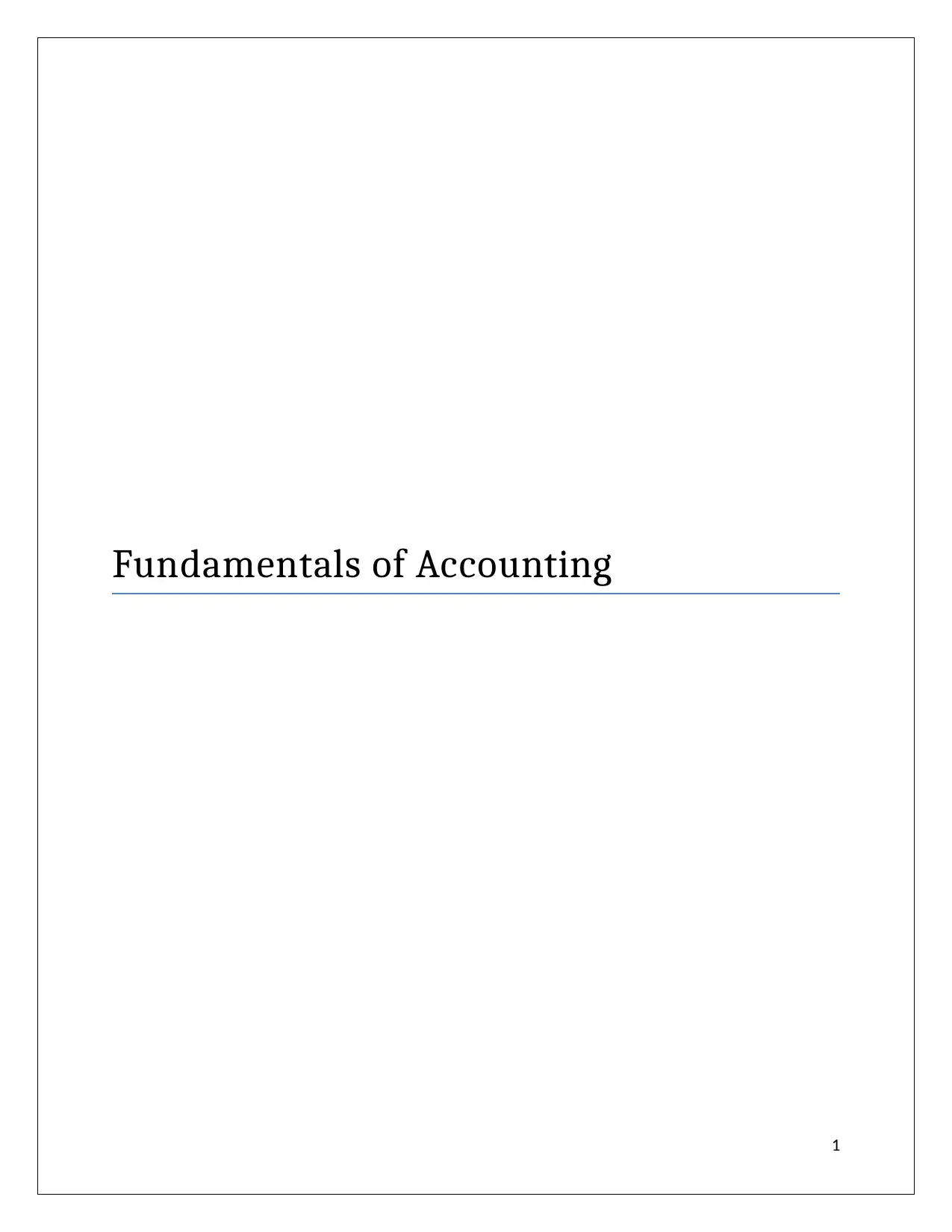
Fundamentals of Accounting
1
1
Paraphrase This Document
Need a fresh take? Get an instant paraphrase of this document with our AI Paraphraser
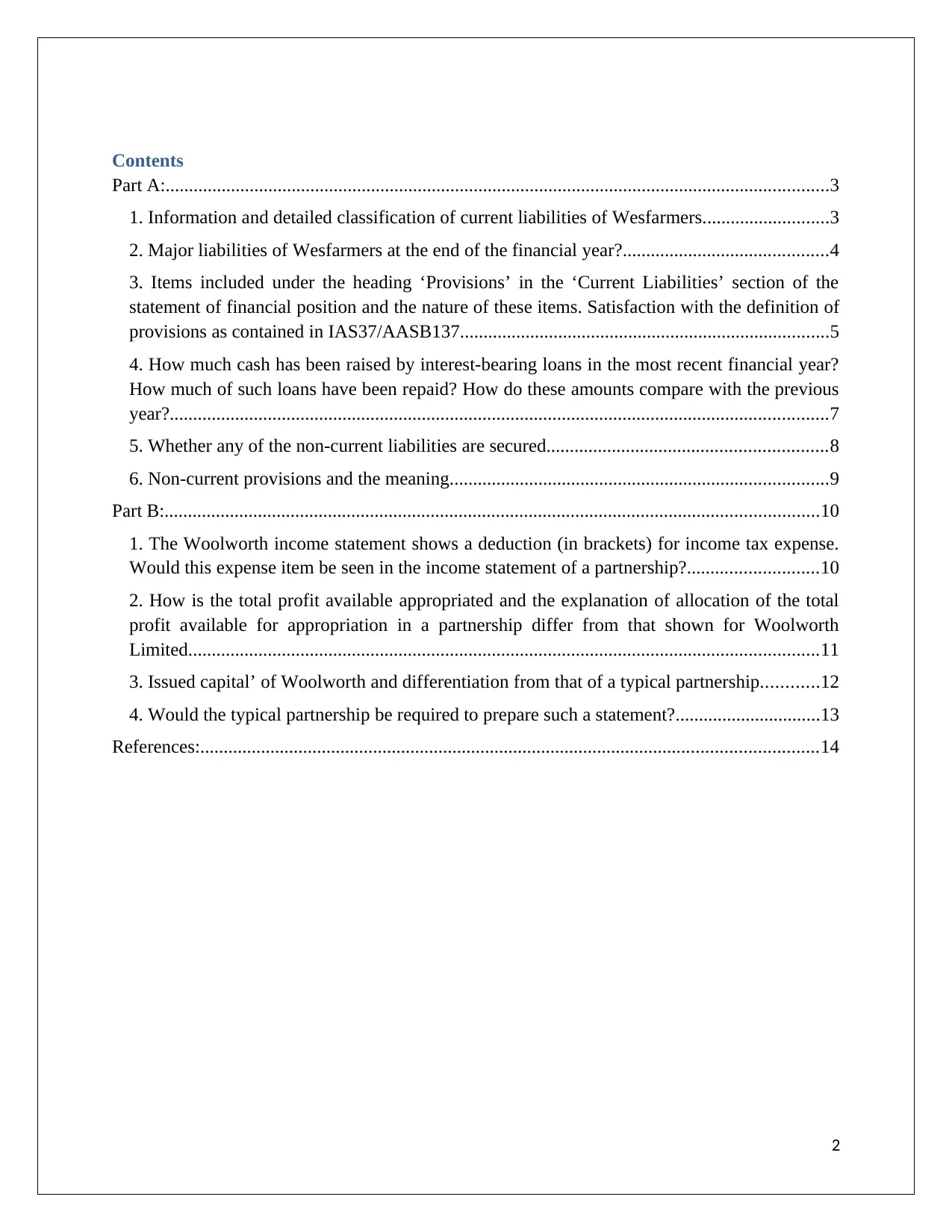
Contents
Part A:..............................................................................................................................................3
1. Information and detailed classification of current liabilities of Wesfarmers...........................3
2. Major liabilities of Wesfarmers at the end of the financial year?............................................4
3. Items included under the heading ‘Provisions’ in the ‘Current Liabilities’ section of the
statement of financial position and the nature of these items. Satisfaction with the definition of
provisions as contained in IAS37/AASB137...............................................................................5
4. How much cash has been raised by interest-bearing loans in the most recent financial year?
How much of such loans have been repaid? How do these amounts compare with the previous
year?.............................................................................................................................................7
5. Whether any of the non-current liabilities are secured............................................................8
6. Non-current provisions and the meaning.................................................................................9
Part B:............................................................................................................................................10
1. The Woolworth income statement shows a deduction (in brackets) for income tax expense.
Would this expense item be seen in the income statement of a partnership?............................10
2. How is the total profit available appropriated and the explanation of allocation of the total
profit available for appropriation in a partnership differ from that shown for Woolworth
Limited.......................................................................................................................................11
3. Issued capital’ of Woolworth and differentiation from that of a typical partnership............12
4. Would the typical partnership be required to prepare such a statement?...............................13
References:....................................................................................................................................14
2
Part A:..............................................................................................................................................3
1. Information and detailed classification of current liabilities of Wesfarmers...........................3
2. Major liabilities of Wesfarmers at the end of the financial year?............................................4
3. Items included under the heading ‘Provisions’ in the ‘Current Liabilities’ section of the
statement of financial position and the nature of these items. Satisfaction with the definition of
provisions as contained in IAS37/AASB137...............................................................................5
4. How much cash has been raised by interest-bearing loans in the most recent financial year?
How much of such loans have been repaid? How do these amounts compare with the previous
year?.............................................................................................................................................7
5. Whether any of the non-current liabilities are secured............................................................8
6. Non-current provisions and the meaning.................................................................................9
Part B:............................................................................................................................................10
1. The Woolworth income statement shows a deduction (in brackets) for income tax expense.
Would this expense item be seen in the income statement of a partnership?............................10
2. How is the total profit available appropriated and the explanation of allocation of the total
profit available for appropriation in a partnership differ from that shown for Woolworth
Limited.......................................................................................................................................11
3. Issued capital’ of Woolworth and differentiation from that of a typical partnership............12
4. Would the typical partnership be required to prepare such a statement?...............................13
References:....................................................................................................................................14
2
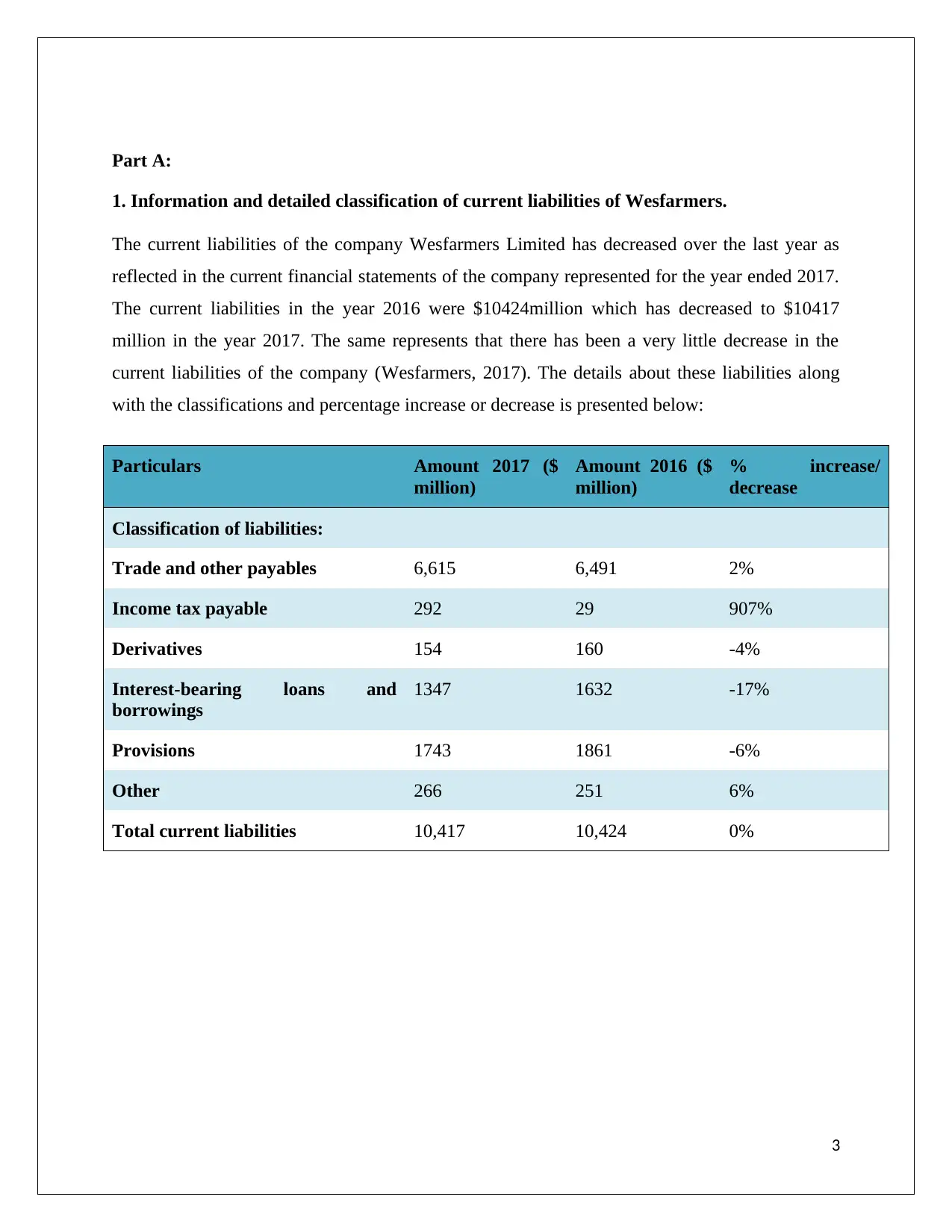
Part A:
1. Information and detailed classification of current liabilities of Wesfarmers.
The current liabilities of the company Wesfarmers Limited has decreased over the last year as
reflected in the current financial statements of the company represented for the year ended 2017.
The current liabilities in the year 2016 were $10424million which has decreased to $10417
million in the year 2017. The same represents that there has been a very little decrease in the
current liabilities of the company (Wesfarmers, 2017). The details about these liabilities along
with the classifications and percentage increase or decrease is presented below:
Particulars Amount 2017 ($
million)
Amount 2016 ($
million)
% increase/
decrease
Classification of liabilities:
Trade and other payables 6,615 6,491 2%
Income tax payable 292 29 907%
Derivatives 154 160 -4%
Interest-bearing loans and
borrowings
1347 1632 -17%
Provisions 1743 1861 -6%
Other 266 251 6%
Total current liabilities 10,417 10,424 0%
3
1. Information and detailed classification of current liabilities of Wesfarmers.
The current liabilities of the company Wesfarmers Limited has decreased over the last year as
reflected in the current financial statements of the company represented for the year ended 2017.
The current liabilities in the year 2016 were $10424million which has decreased to $10417
million in the year 2017. The same represents that there has been a very little decrease in the
current liabilities of the company (Wesfarmers, 2017). The details about these liabilities along
with the classifications and percentage increase or decrease is presented below:
Particulars Amount 2017 ($
million)
Amount 2016 ($
million)
% increase/
decrease
Classification of liabilities:
Trade and other payables 6,615 6,491 2%
Income tax payable 292 29 907%
Derivatives 154 160 -4%
Interest-bearing loans and
borrowings
1347 1632 -17%
Provisions 1743 1861 -6%
Other 266 251 6%
Total current liabilities 10,417 10,424 0%
3
⊘ This is a preview!⊘
Do you want full access?
Subscribe today to unlock all pages.

Trusted by 1+ million students worldwide
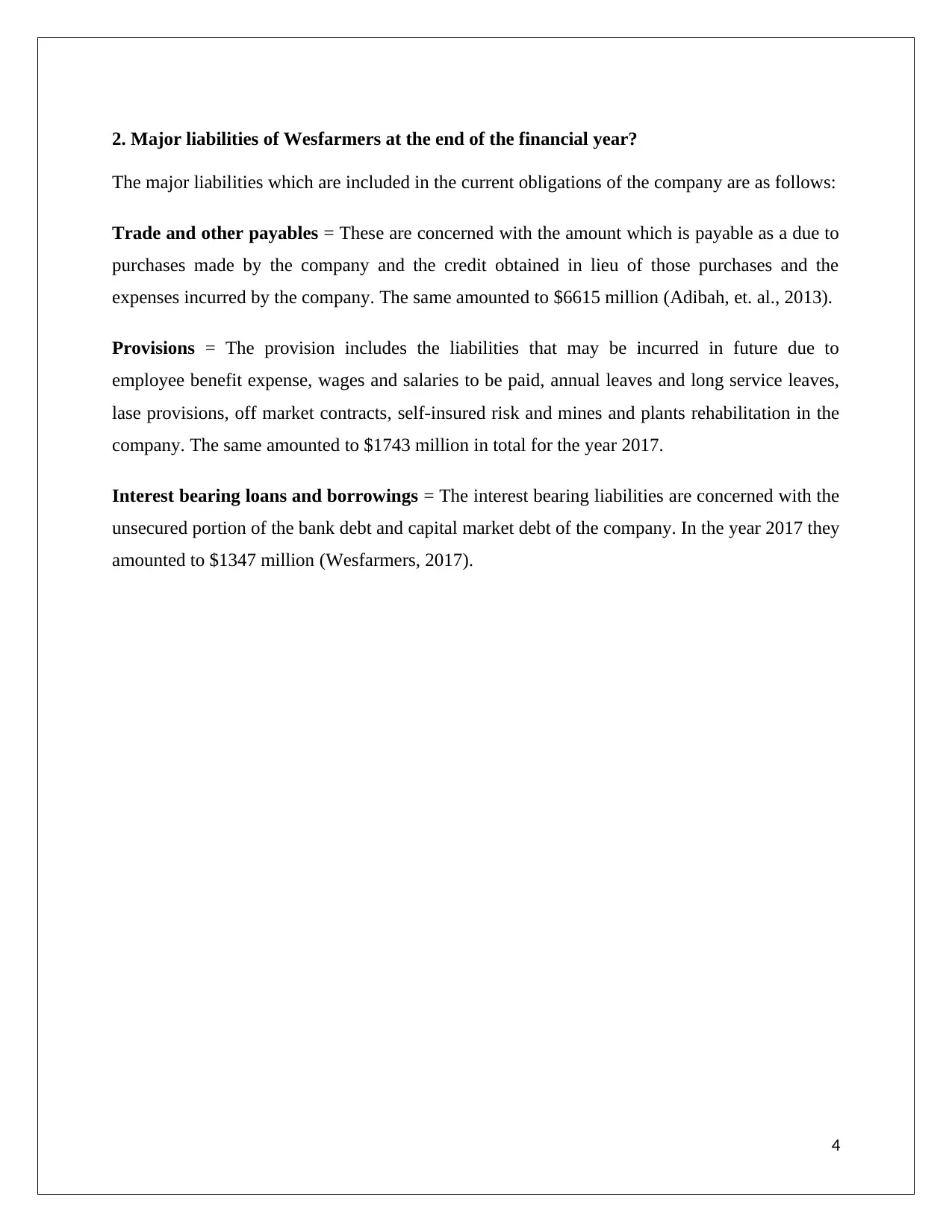
2. Major liabilities of Wesfarmers at the end of the financial year?
The major liabilities which are included in the current obligations of the company are as follows:
Trade and other payables = These are concerned with the amount which is payable as a due to
purchases made by the company and the credit obtained in lieu of those purchases and the
expenses incurred by the company. The same amounted to $6615 million (Adibah, et. al., 2013).
Provisions = The provision includes the liabilities that may be incurred in future due to
employee benefit expense, wages and salaries to be paid, annual leaves and long service leaves,
lase provisions, off market contracts, self-insured risk and mines and plants rehabilitation in the
company. The same amounted to $1743 million in total for the year 2017.
Interest bearing loans and borrowings = The interest bearing liabilities are concerned with the
unsecured portion of the bank debt and capital market debt of the company. In the year 2017 they
amounted to $1347 million (Wesfarmers, 2017).
4
The major liabilities which are included in the current obligations of the company are as follows:
Trade and other payables = These are concerned with the amount which is payable as a due to
purchases made by the company and the credit obtained in lieu of those purchases and the
expenses incurred by the company. The same amounted to $6615 million (Adibah, et. al., 2013).
Provisions = The provision includes the liabilities that may be incurred in future due to
employee benefit expense, wages and salaries to be paid, annual leaves and long service leaves,
lase provisions, off market contracts, self-insured risk and mines and plants rehabilitation in the
company. The same amounted to $1743 million in total for the year 2017.
Interest bearing loans and borrowings = The interest bearing liabilities are concerned with the
unsecured portion of the bank debt and capital market debt of the company. In the year 2017 they
amounted to $1347 million (Wesfarmers, 2017).
4
Paraphrase This Document
Need a fresh take? Get an instant paraphrase of this document with our AI Paraphraser
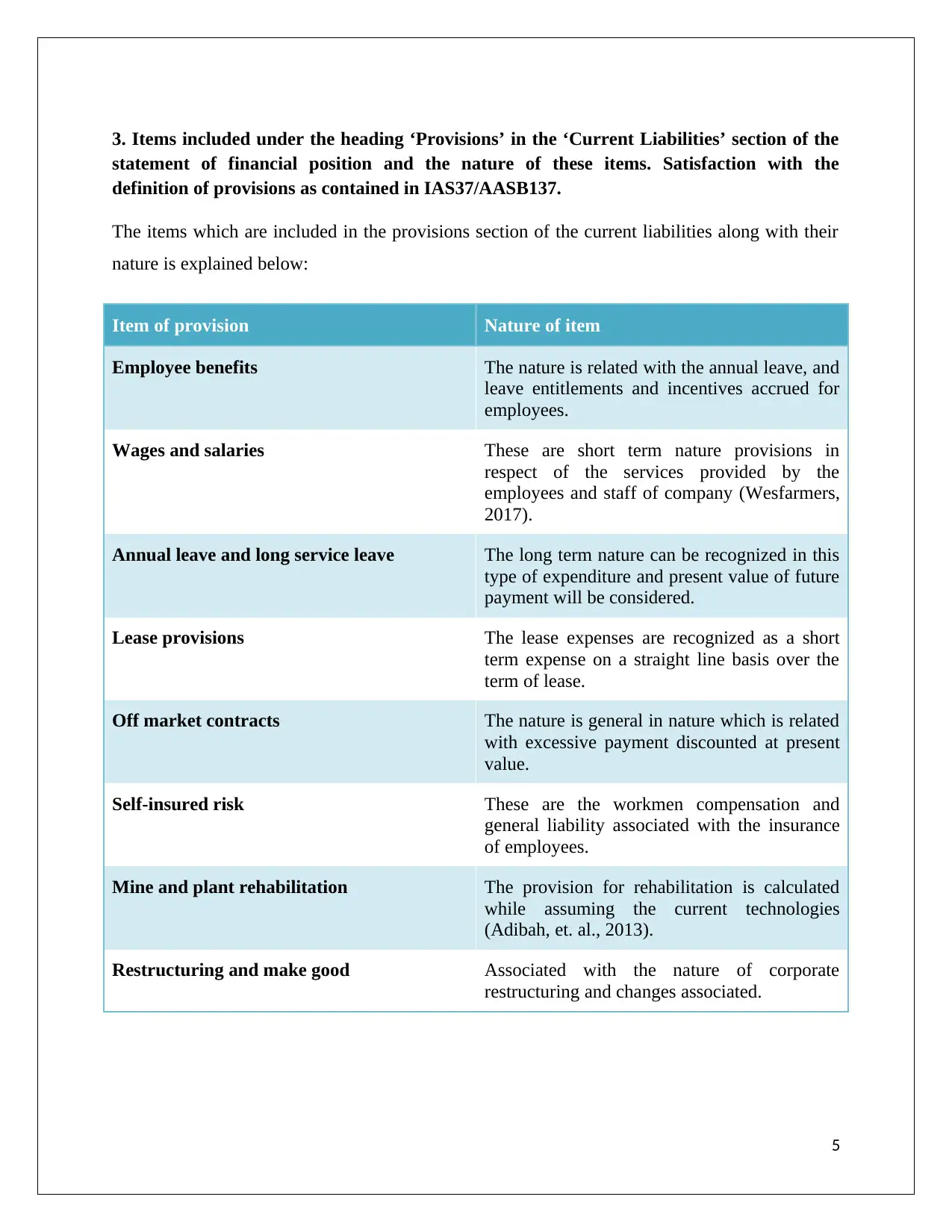
3. Items included under the heading ‘Provisions’ in the ‘Current Liabilities’ section of the
statement of financial position and the nature of these items. Satisfaction with the
definition of provisions as contained in IAS37/AASB137.
The items which are included in the provisions section of the current liabilities along with their
nature is explained below:
Item of provision Nature of item
Employee benefits The nature is related with the annual leave, and
leave entitlements and incentives accrued for
employees.
Wages and salaries These are short term nature provisions in
respect of the services provided by the
employees and staff of company (Wesfarmers,
2017).
Annual leave and long service leave The long term nature can be recognized in this
type of expenditure and present value of future
payment will be considered.
Lease provisions The lease expenses are recognized as a short
term expense on a straight line basis over the
term of lease.
Off market contracts The nature is general in nature which is related
with excessive payment discounted at present
value.
Self-insured risk These are the workmen compensation and
general liability associated with the insurance
of employees.
Mine and plant rehabilitation The provision for rehabilitation is calculated
while assuming the current technologies
(Adibah, et. al., 2013).
Restructuring and make good Associated with the nature of corporate
restructuring and changes associated.
5
statement of financial position and the nature of these items. Satisfaction with the
definition of provisions as contained in IAS37/AASB137.
The items which are included in the provisions section of the current liabilities along with their
nature is explained below:
Item of provision Nature of item
Employee benefits The nature is related with the annual leave, and
leave entitlements and incentives accrued for
employees.
Wages and salaries These are short term nature provisions in
respect of the services provided by the
employees and staff of company (Wesfarmers,
2017).
Annual leave and long service leave The long term nature can be recognized in this
type of expenditure and present value of future
payment will be considered.
Lease provisions The lease expenses are recognized as a short
term expense on a straight line basis over the
term of lease.
Off market contracts The nature is general in nature which is related
with excessive payment discounted at present
value.
Self-insured risk These are the workmen compensation and
general liability associated with the insurance
of employees.
Mine and plant rehabilitation The provision for rehabilitation is calculated
while assuming the current technologies
(Adibah, et. al., 2013).
Restructuring and make good Associated with the nature of corporate
restructuring and changes associated.
5
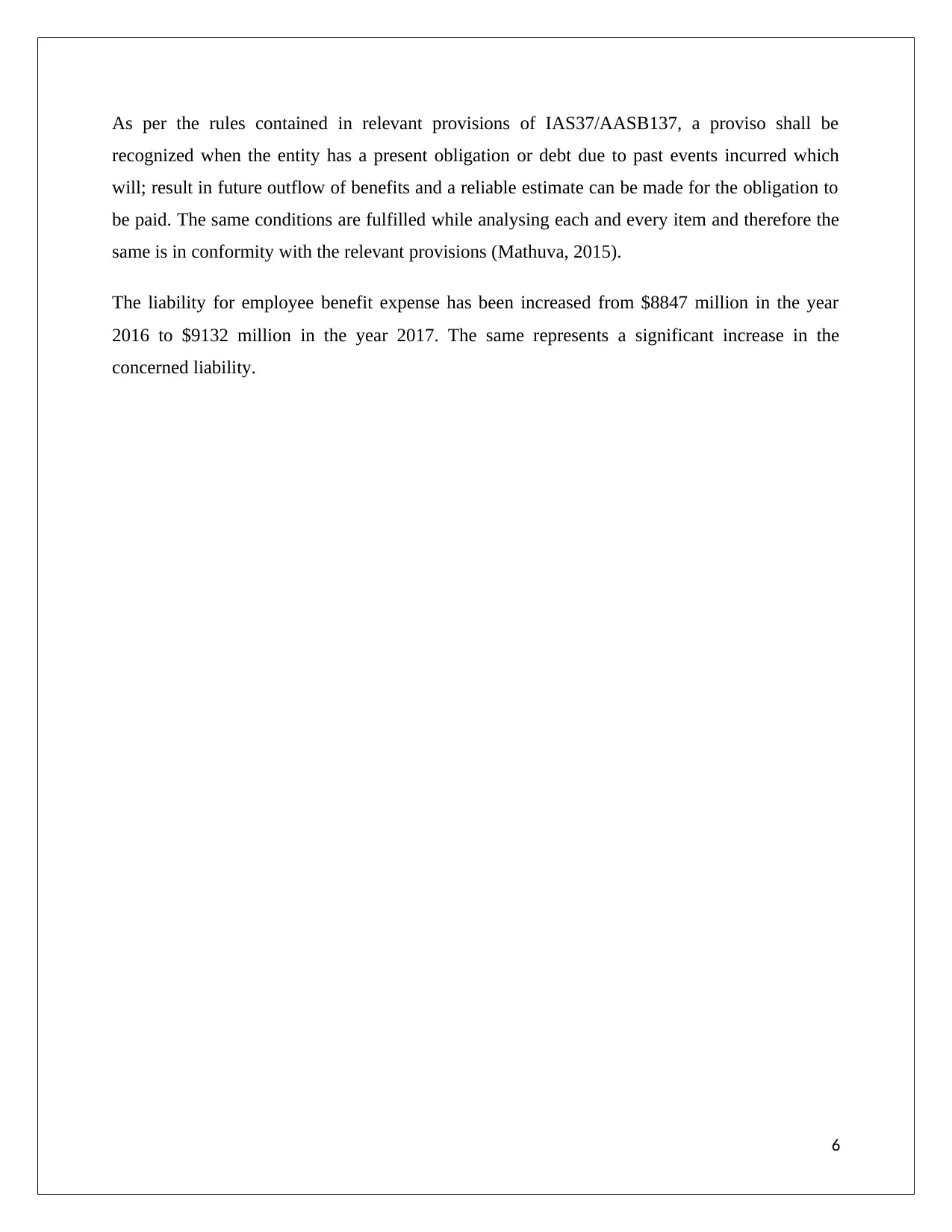
As per the rules contained in relevant provisions of IAS37/AASB137, a proviso shall be
recognized when the entity has a present obligation or debt due to past events incurred which
will; result in future outflow of benefits and a reliable estimate can be made for the obligation to
be paid. The same conditions are fulfilled while analysing each and every item and therefore the
same is in conformity with the relevant provisions (Mathuva, 2015).
The liability for employee benefit expense has been increased from $8847 million in the year
2016 to $9132 million in the year 2017. The same represents a significant increase in the
concerned liability.
6
recognized when the entity has a present obligation or debt due to past events incurred which
will; result in future outflow of benefits and a reliable estimate can be made for the obligation to
be paid. The same conditions are fulfilled while analysing each and every item and therefore the
same is in conformity with the relevant provisions (Mathuva, 2015).
The liability for employee benefit expense has been increased from $8847 million in the year
2016 to $9132 million in the year 2017. The same represents a significant increase in the
concerned liability.
6
⊘ This is a preview!⊘
Do you want full access?
Subscribe today to unlock all pages.

Trusted by 1+ million students worldwide
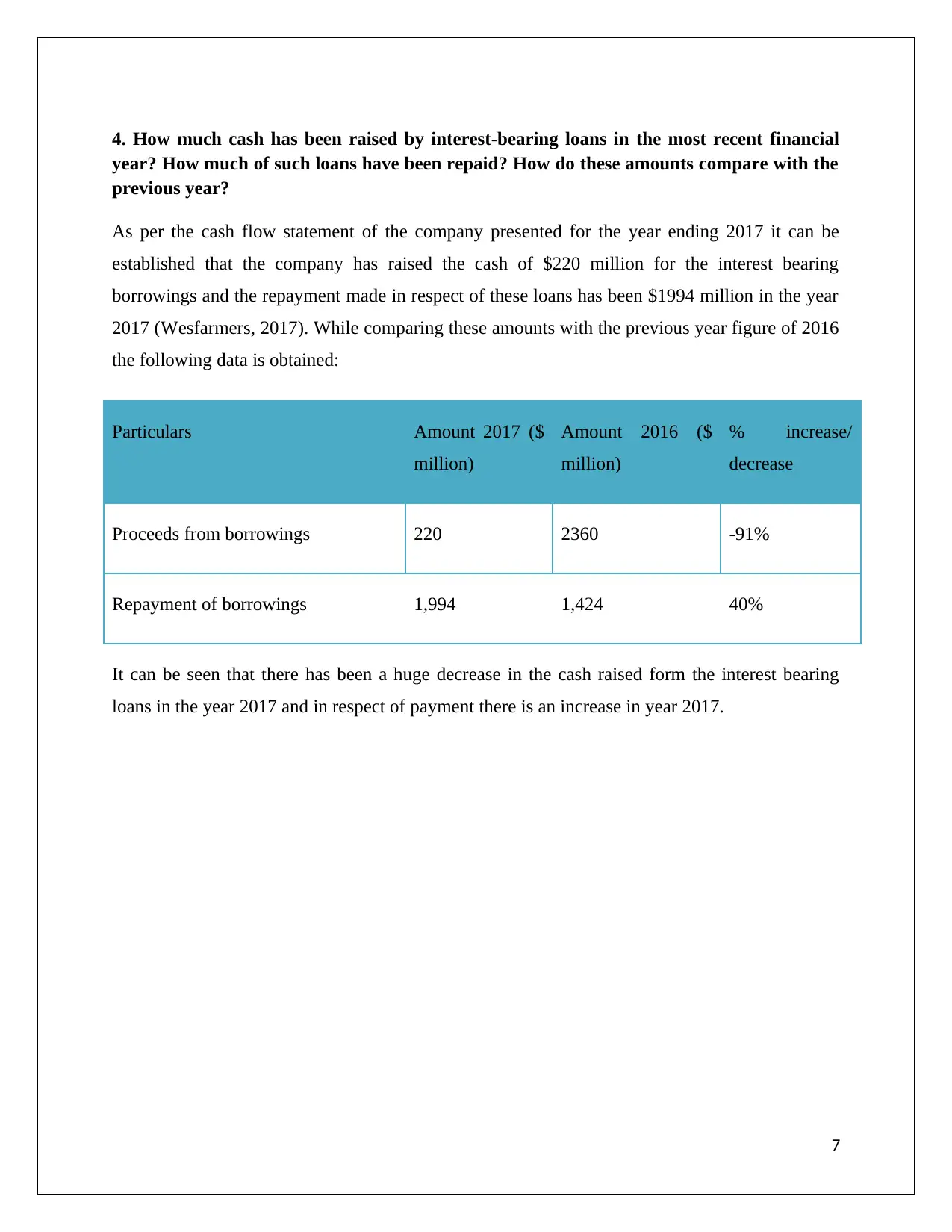
4. How much cash has been raised by interest-bearing loans in the most recent financial
year? How much of such loans have been repaid? How do these amounts compare with the
previous year?
As per the cash flow statement of the company presented for the year ending 2017 it can be
established that the company has raised the cash of $220 million for the interest bearing
borrowings and the repayment made in respect of these loans has been $1994 million in the year
2017 (Wesfarmers, 2017). While comparing these amounts with the previous year figure of 2016
the following data is obtained:
Particulars Amount 2017 ($
million)
Amount 2016 ($
million)
% increase/
decrease
Proceeds from borrowings 220 2360 -91%
Repayment of borrowings 1,994 1,424 40%
It can be seen that there has been a huge decrease in the cash raised form the interest bearing
loans in the year 2017 and in respect of payment there is an increase in year 2017.
7
year? How much of such loans have been repaid? How do these amounts compare with the
previous year?
As per the cash flow statement of the company presented for the year ending 2017 it can be
established that the company has raised the cash of $220 million for the interest bearing
borrowings and the repayment made in respect of these loans has been $1994 million in the year
2017 (Wesfarmers, 2017). While comparing these amounts with the previous year figure of 2016
the following data is obtained:
Particulars Amount 2017 ($
million)
Amount 2016 ($
million)
% increase/
decrease
Proceeds from borrowings 220 2360 -91%
Repayment of borrowings 1,994 1,424 40%
It can be seen that there has been a huge decrease in the cash raised form the interest bearing
loans in the year 2017 and in respect of payment there is an increase in year 2017.
7
Paraphrase This Document
Need a fresh take? Get an instant paraphrase of this document with our AI Paraphraser
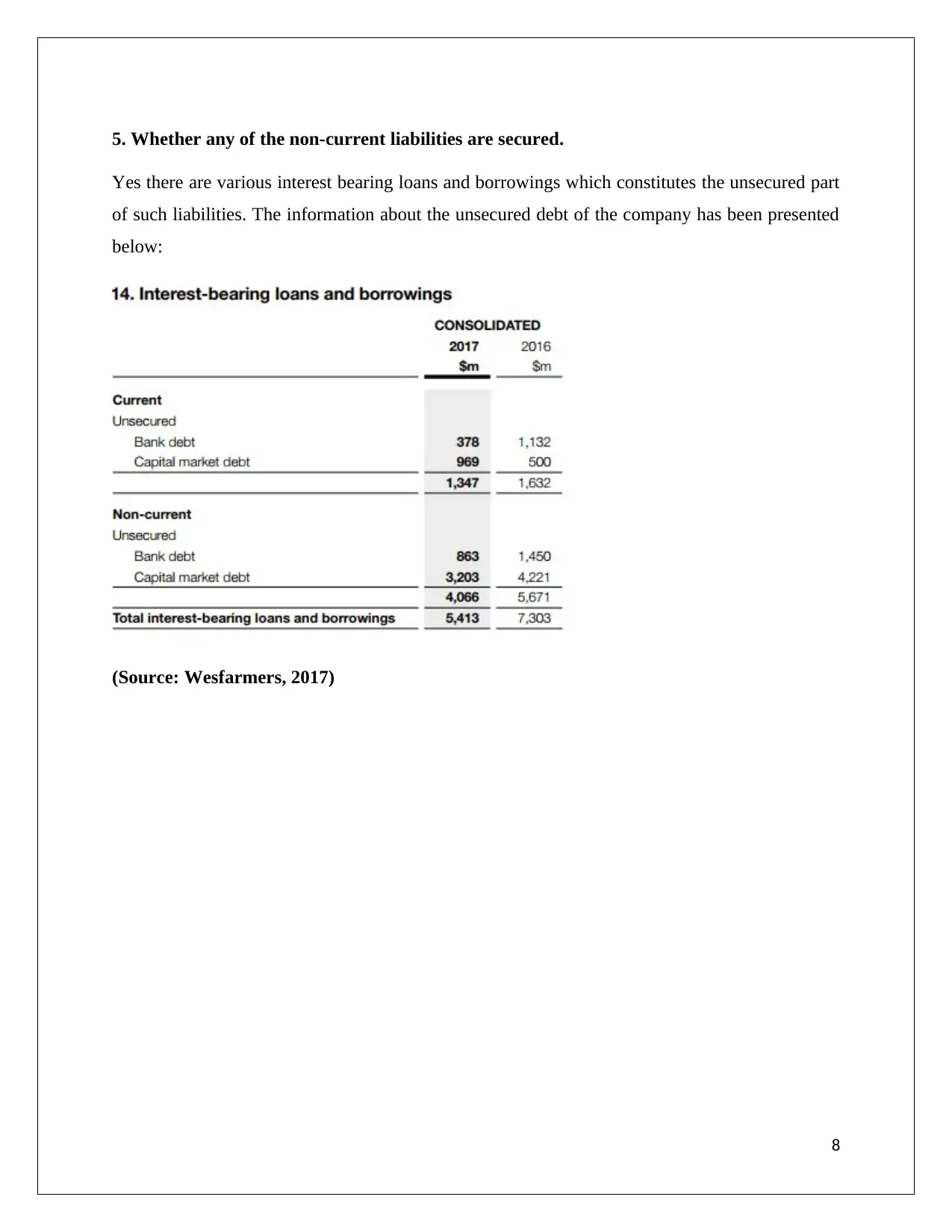
5. Whether any of the non-current liabilities are secured.
Yes there are various interest bearing loans and borrowings which constitutes the unsecured part
of such liabilities. The information about the unsecured debt of the company has been presented
below:
(Source: Wesfarmers, 2017)
8
Yes there are various interest bearing loans and borrowings which constitutes the unsecured part
of such liabilities. The information about the unsecured debt of the company has been presented
below:
(Source: Wesfarmers, 2017)
8
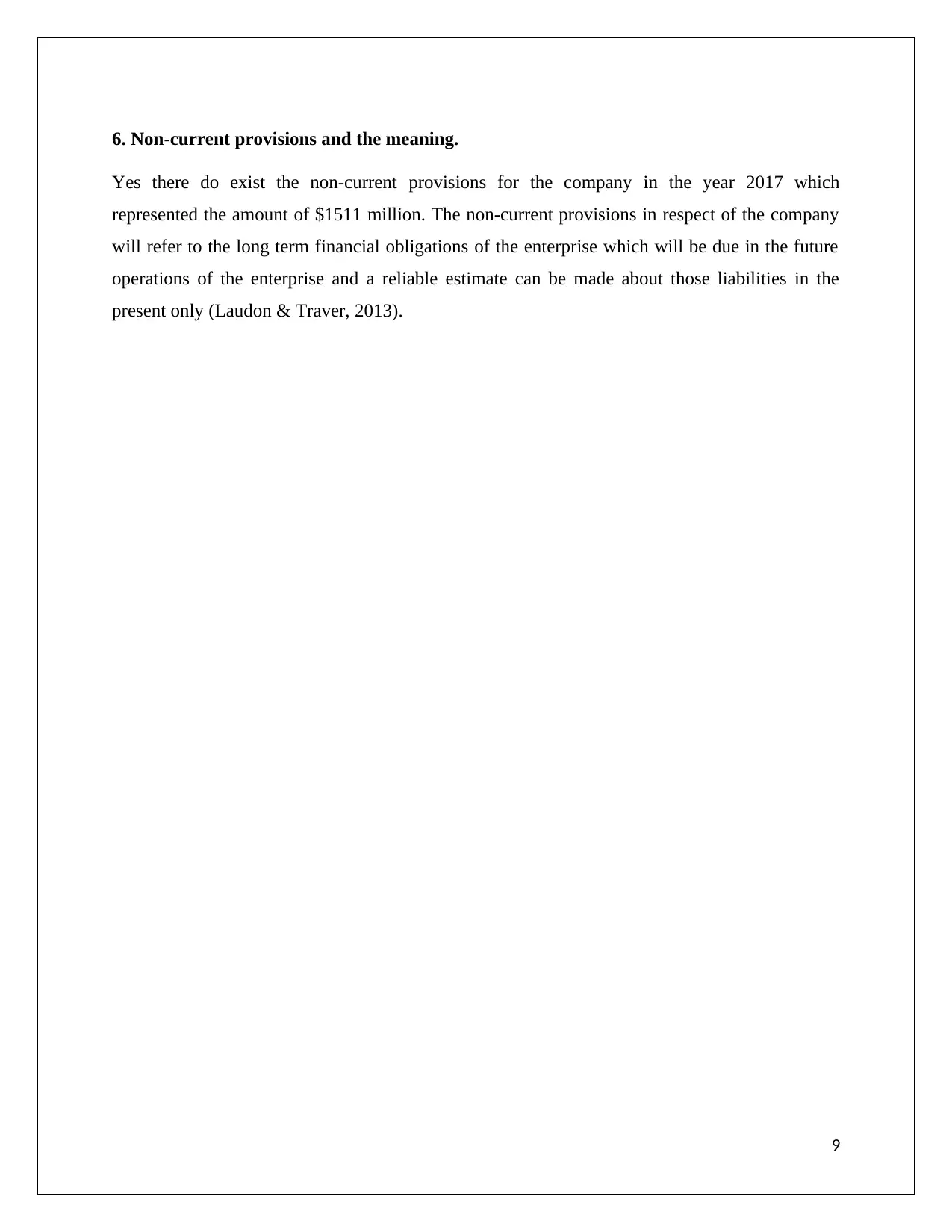
6. Non-current provisions and the meaning.
Yes there do exist the non-current provisions for the company in the year 2017 which
represented the amount of $1511 million. The non-current provisions in respect of the company
will refer to the long term financial obligations of the enterprise which will be due in the future
operations of the enterprise and a reliable estimate can be made about those liabilities in the
present only (Laudon & Traver, 2013).
9
Yes there do exist the non-current provisions for the company in the year 2017 which
represented the amount of $1511 million. The non-current provisions in respect of the company
will refer to the long term financial obligations of the enterprise which will be due in the future
operations of the enterprise and a reliable estimate can be made about those liabilities in the
present only (Laudon & Traver, 2013).
9
⊘ This is a preview!⊘
Do you want full access?
Subscribe today to unlock all pages.

Trusted by 1+ million students worldwide
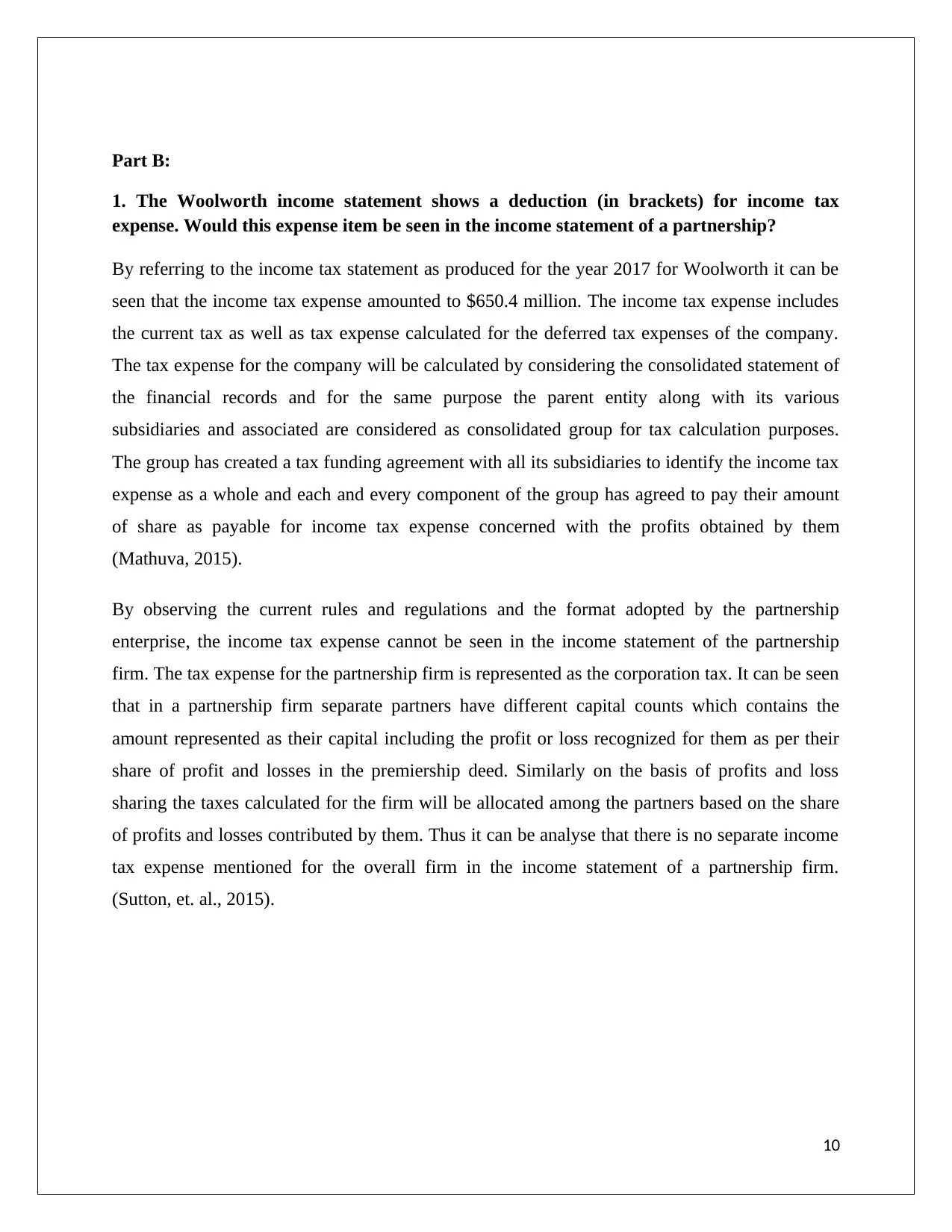
Part B:
1. The Woolworth income statement shows a deduction (in brackets) for income tax
expense. Would this expense item be seen in the income statement of a partnership?
By referring to the income tax statement as produced for the year 2017 for Woolworth it can be
seen that the income tax expense amounted to $650.4 million. The income tax expense includes
the current tax as well as tax expense calculated for the deferred tax expenses of the company.
The tax expense for the company will be calculated by considering the consolidated statement of
the financial records and for the same purpose the parent entity along with its various
subsidiaries and associated are considered as consolidated group for tax calculation purposes.
The group has created a tax funding agreement with all its subsidiaries to identify the income tax
expense as a whole and each and every component of the group has agreed to pay their amount
of share as payable for income tax expense concerned with the profits obtained by them
(Mathuva, 2015).
By observing the current rules and regulations and the format adopted by the partnership
enterprise, the income tax expense cannot be seen in the income statement of the partnership
firm. The tax expense for the partnership firm is represented as the corporation tax. It can be seen
that in a partnership firm separate partners have different capital counts which contains the
amount represented as their capital including the profit or loss recognized for them as per their
share of profit and losses in the premiership deed. Similarly on the basis of profits and loss
sharing the taxes calculated for the firm will be allocated among the partners based on the share
of profits and losses contributed by them. Thus it can be analyse that there is no separate income
tax expense mentioned for the overall firm in the income statement of a partnership firm.
(Sutton, et. al., 2015).
10
1. The Woolworth income statement shows a deduction (in brackets) for income tax
expense. Would this expense item be seen in the income statement of a partnership?
By referring to the income tax statement as produced for the year 2017 for Woolworth it can be
seen that the income tax expense amounted to $650.4 million. The income tax expense includes
the current tax as well as tax expense calculated for the deferred tax expenses of the company.
The tax expense for the company will be calculated by considering the consolidated statement of
the financial records and for the same purpose the parent entity along with its various
subsidiaries and associated are considered as consolidated group for tax calculation purposes.
The group has created a tax funding agreement with all its subsidiaries to identify the income tax
expense as a whole and each and every component of the group has agreed to pay their amount
of share as payable for income tax expense concerned with the profits obtained by them
(Mathuva, 2015).
By observing the current rules and regulations and the format adopted by the partnership
enterprise, the income tax expense cannot be seen in the income statement of the partnership
firm. The tax expense for the partnership firm is represented as the corporation tax. It can be seen
that in a partnership firm separate partners have different capital counts which contains the
amount represented as their capital including the profit or loss recognized for them as per their
share of profit and losses in the premiership deed. Similarly on the basis of profits and loss
sharing the taxes calculated for the firm will be allocated among the partners based on the share
of profits and losses contributed by them. Thus it can be analyse that there is no separate income
tax expense mentioned for the overall firm in the income statement of a partnership firm.
(Sutton, et. al., 2015).
10
Paraphrase This Document
Need a fresh take? Get an instant paraphrase of this document with our AI Paraphraser
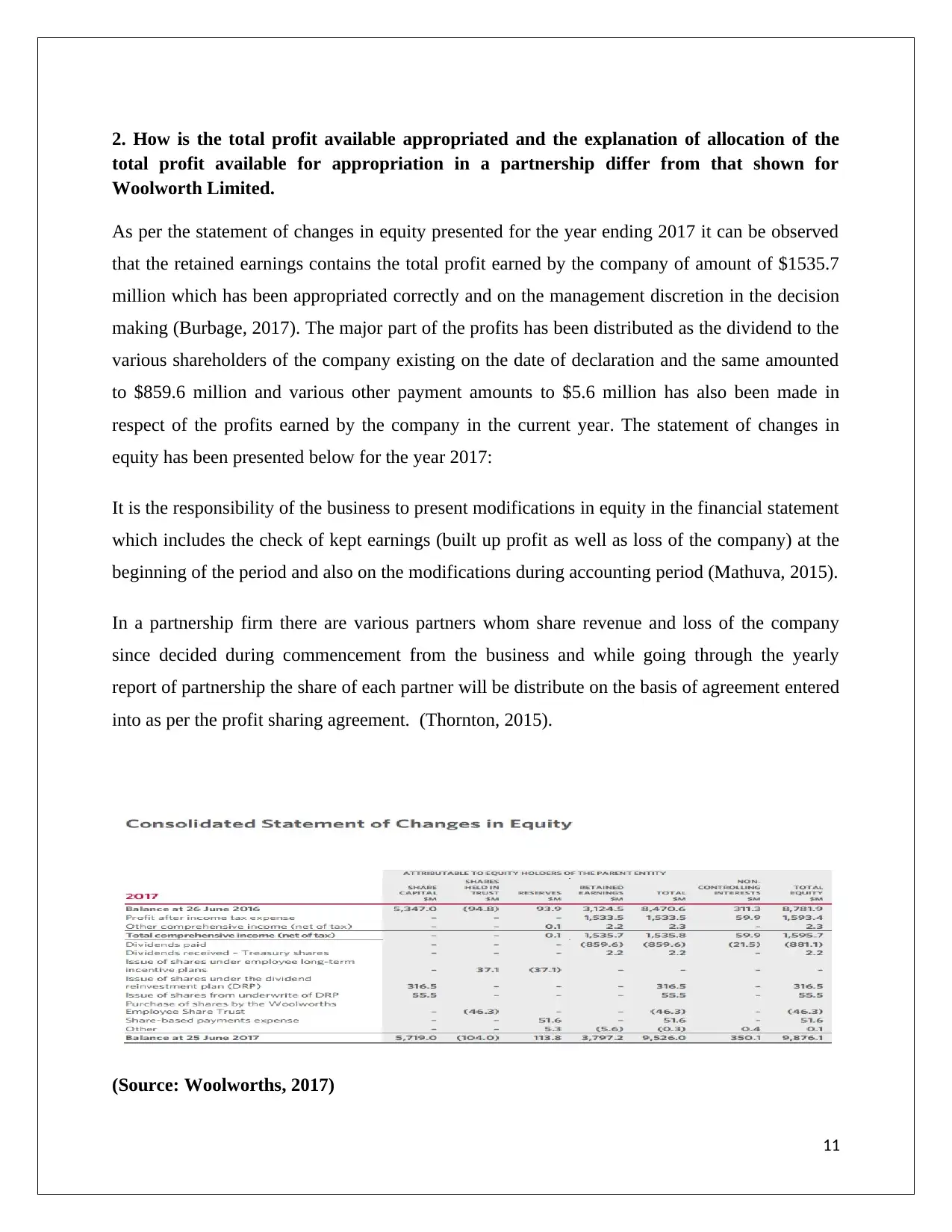
2. How is the total profit available appropriated and the explanation of allocation of the
total profit available for appropriation in a partnership differ from that shown for
Woolworth Limited.
As per the statement of changes in equity presented for the year ending 2017 it can be observed
that the retained earnings contains the total profit earned by the company of amount of $1535.7
million which has been appropriated correctly and on the management discretion in the decision
making (Burbage, 2017). The major part of the profits has been distributed as the dividend to the
various shareholders of the company existing on the date of declaration and the same amounted
to $859.6 million and various other payment amounts to $5.6 million has also been made in
respect of the profits earned by the company in the current year. The statement of changes in
equity has been presented below for the year 2017:
It is the responsibility of the business to present modifications in equity in the financial statement
which includes the check of kept earnings (built up profit as well as loss of the company) at the
beginning of the period and also on the modifications during accounting period (Mathuva, 2015).
In a partnership firm there are various partners whom share revenue and loss of the company
since decided during commencement from the business and while going through the yearly
report of partnership the share of each partner will be distribute on the basis of agreement entered
into as per the profit sharing agreement. (Thornton, 2015).
(Source: Woolworths, 2017)
11
total profit available for appropriation in a partnership differ from that shown for
Woolworth Limited.
As per the statement of changes in equity presented for the year ending 2017 it can be observed
that the retained earnings contains the total profit earned by the company of amount of $1535.7
million which has been appropriated correctly and on the management discretion in the decision
making (Burbage, 2017). The major part of the profits has been distributed as the dividend to the
various shareholders of the company existing on the date of declaration and the same amounted
to $859.6 million and various other payment amounts to $5.6 million has also been made in
respect of the profits earned by the company in the current year. The statement of changes in
equity has been presented below for the year 2017:
It is the responsibility of the business to present modifications in equity in the financial statement
which includes the check of kept earnings (built up profit as well as loss of the company) at the
beginning of the period and also on the modifications during accounting period (Mathuva, 2015).
In a partnership firm there are various partners whom share revenue and loss of the company
since decided during commencement from the business and while going through the yearly
report of partnership the share of each partner will be distribute on the basis of agreement entered
into as per the profit sharing agreement. (Thornton, 2015).
(Source: Woolworths, 2017)
11
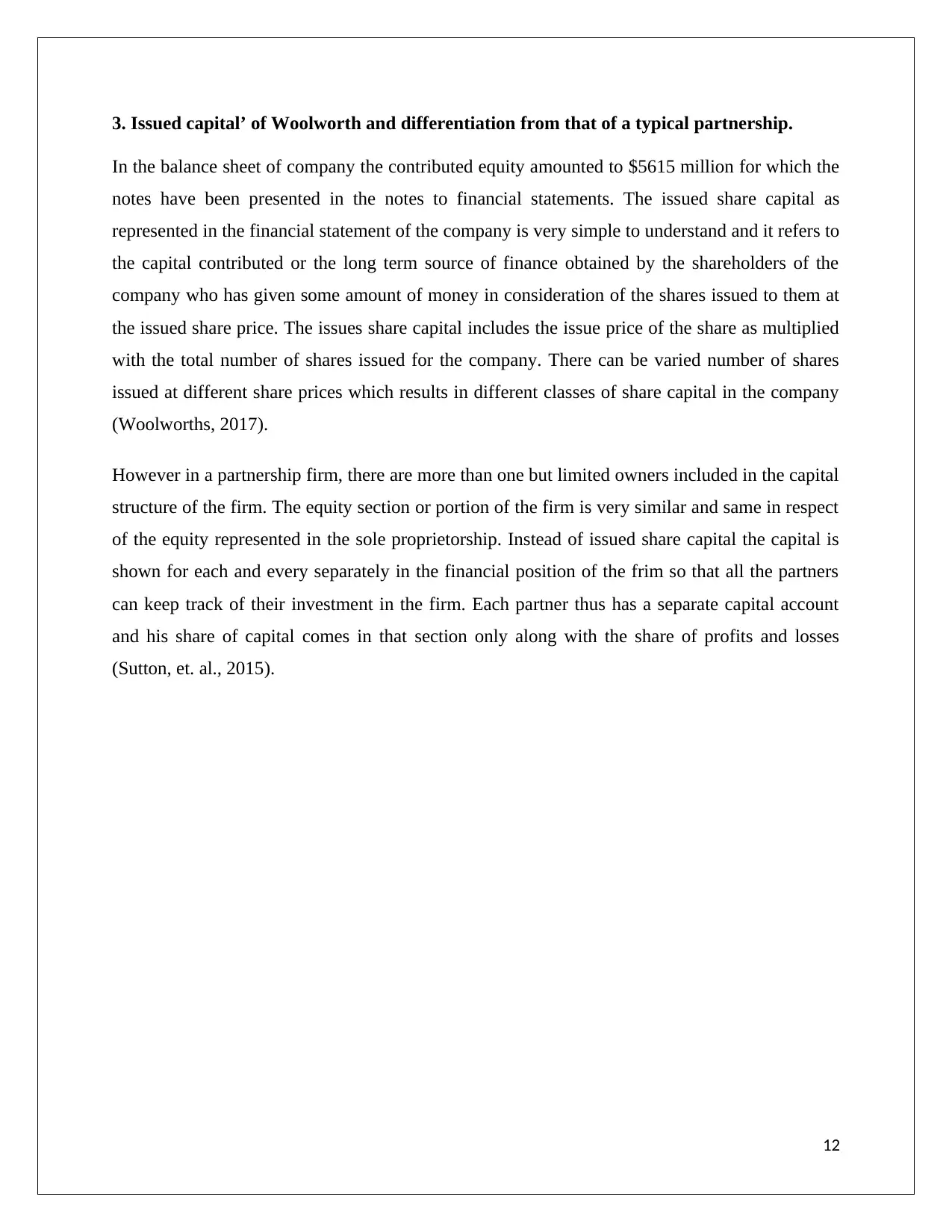
3. Issued capital’ of Woolworth and differentiation from that of a typical partnership.
In the balance sheet of company the contributed equity amounted to $5615 million for which the
notes have been presented in the notes to financial statements. The issued share capital as
represented in the financial statement of the company is very simple to understand and it refers to
the capital contributed or the long term source of finance obtained by the shareholders of the
company who has given some amount of money in consideration of the shares issued to them at
the issued share price. The issues share capital includes the issue price of the share as multiplied
with the total number of shares issued for the company. There can be varied number of shares
issued at different share prices which results in different classes of share capital in the company
(Woolworths, 2017).
However in a partnership firm, there are more than one but limited owners included in the capital
structure of the firm. The equity section or portion of the firm is very similar and same in respect
of the equity represented in the sole proprietorship. Instead of issued share capital the capital is
shown for each and every separately in the financial position of the frim so that all the partners
can keep track of their investment in the firm. Each partner thus has a separate capital account
and his share of capital comes in that section only along with the share of profits and losses
(Sutton, et. al., 2015).
12
In the balance sheet of company the contributed equity amounted to $5615 million for which the
notes have been presented in the notes to financial statements. The issued share capital as
represented in the financial statement of the company is very simple to understand and it refers to
the capital contributed or the long term source of finance obtained by the shareholders of the
company who has given some amount of money in consideration of the shares issued to them at
the issued share price. The issues share capital includes the issue price of the share as multiplied
with the total number of shares issued for the company. There can be varied number of shares
issued at different share prices which results in different classes of share capital in the company
(Woolworths, 2017).
However in a partnership firm, there are more than one but limited owners included in the capital
structure of the firm. The equity section or portion of the firm is very similar and same in respect
of the equity represented in the sole proprietorship. Instead of issued share capital the capital is
shown for each and every separately in the financial position of the frim so that all the partners
can keep track of their investment in the firm. Each partner thus has a separate capital account
and his share of capital comes in that section only along with the share of profits and losses
(Sutton, et. al., 2015).
12
⊘ This is a preview!⊘
Do you want full access?
Subscribe today to unlock all pages.

Trusted by 1+ million students worldwide
1 out of 14
Related Documents
Your All-in-One AI-Powered Toolkit for Academic Success.
+13062052269
info@desklib.com
Available 24*7 on WhatsApp / Email
![[object Object]](/_next/static/media/star-bottom.7253800d.svg)
Unlock your academic potential
Copyright © 2020–2025 A2Z Services. All Rights Reserved. Developed and managed by ZUCOL.





